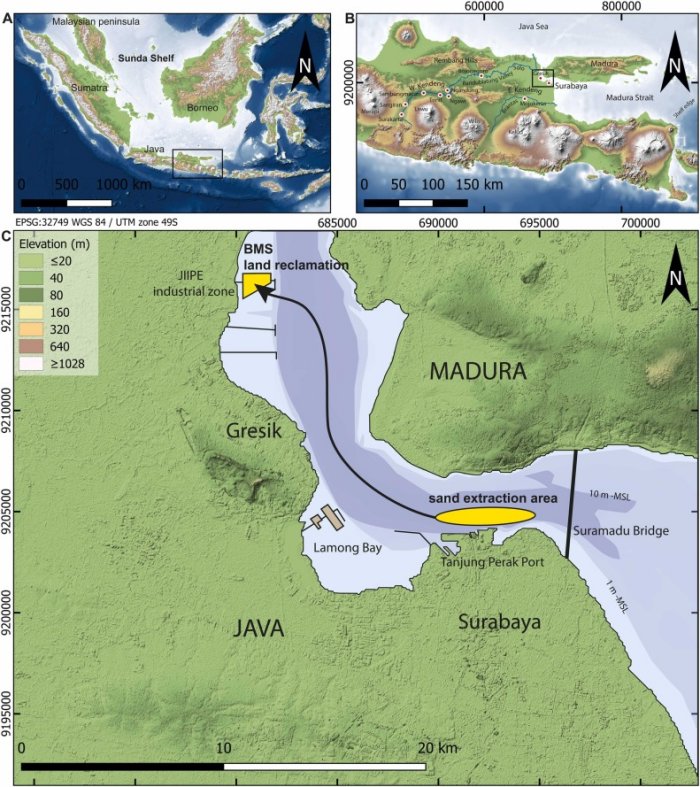Conny Waters – AncientPages.com – Recent archaeological finds from the seabed of the Madura Strait separating the Indonesian islands of Java and Madura, have yielded valuable insights into the existence of Homo erectus approximately 140,000 years ago.
The Sunda Shelf of Southeast Asia, with the Indonesian archipelago. . The area where the fossils were found (‘sand extraction area’. Image source
According to Harold Berghuis, an archaeologist from Leiden, skull fragments and other fossil remains give us a much better understanding the living conditions and habitats of these early humans.
During dredging operations in the Madura Strait, archaeologists uncovered the fossilized remains of 36 vertebrate species. This marks the first discovery of fossils from the seabed located between the Indonesian islands.
Once, the region referred to as Sundaland was historically an extensive lowland area. In this now submerged area, researchers discovered two skull fragments of Homo erectus.
The discoveries provide a distinctive portrayal of a prehistoric ecosystem and clarify the role that Homo erectus played within it.
Fossil remains of Homo erectus have been previously discovered on the island of Java, of which most famous are skulls from sites such as Trinil, Sangiran and Ngandong.
Until recently, it was widely believed by researchers that Homo erectus had existed in prolonged isolation on the island of Java. However, recent discoveries indicate that the Javanese Homo erectus dispersed across the bordering lowlands of Sundaland during epochs characterized by lower sea levels.
It is likely that the species spread along the principal river systems.
‘Here they had water, shellfish, fish, edible plants, seeds and fruit all year round’, says Berghuis, who has indicated that it was previously established that Homo erectus engaged in the collection of river shells.
The recent discoveries include evidence of cut marks on the bones of water turtles, as well as a significant quantity of fractured bovid bones. These findings suggest activities related to hunting and the consumption of bone marrow.
The new finds show that the Sundaland Homo erectus actively hunted healthy, strong bovids, the most diverse, widespread, and abundant family of hoofed mammals.
In earlier Homo erectus populations on Java, this practice was not observed. However, it is known to exist among more modern human species from the Asian mainland. It is possible that Homo erectus adopted this behavior by imitating these populations, the researcher commented.
This implies the possibility of interactions between these hominin groups, and perhaps even genetic exchange.
See also:
Unknown 500,000-Year-Old Migration Route Of Homo Erectus From Africa – Discovered
The site has been studied in detail over the past five years.
‘Often, only the most attractive material is published in this type of research, such as hominin fossils. We present the results of our studies in four extensive, richly illustrated articles, creating a unique window to the drowned Sundaland of 140,000 years ago,’ says Berghuis. The research was carried out by researchers from Leiden University, the Netherlands, in collaboration with a team of specialists from Indonesia, Australia, Germany and Japan.
What Did Sundaland Look Like?
In prehistoric times, what we know as the Indonesian archipelago was an extensive lowland in periods with lower sea levels, with the current islands as mountain ranges. ‘We call this area Sundaland’, says Berghuis. ‘Homo erectus could disperse from the Asian mainland to Java.’ The vast majority of Sundaland is now a shallow sea, and until now, fossils had never been found in this area.
‘This makes our discoveries truly unique,’ says Berghuis. ‘The fossils come from a drowned river valley, which filled up over time with river sand. We have been able to date the material to approximately 140,000 years ago. That was the penultimate glacial period. Large parts of the northern hemisphere were covered by glaciers, and so much water on Earth was stored in ice caps that the global sea level was 100 metres lower than today.’
Sundaland Was Once Like African Savannah
At that time, Sundaland resembled today’s African savannah: a fairly dry grassland with narrow strips of forest along the major rivers and a rich fauna including various species of elephants, bovids, rhinos and crocodiles.
‘Most of these species are extinct, whereas others are the ancestors of species that still occur in the region, but whose survival is seriously threatened. The Asian hippo is extinct. Carnivorous Komodo dragons are now restricted to the islands of Komodo and Flores, and river sharks are extremely rare in the major rivers of India and Thailand.
These animals thrived in ancient Sundaland, which is crucial for understanding Southeast Asia’s biodiversity.
The fossil collection is in the Geological Museum in Bandung, Indonesia. The museum plans an exhibition with possible temporary shows elsewhere.
Written by Conny Waters – AncientPages.com Staff Writer



